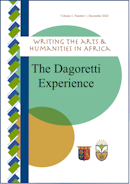Cosmopolitanisms : premise naming in Dagoretti and Nairobi West as a site for exercising identity
Abstract
What happens when a space is at once seemingly ancestral but with ties to a brash city like Nairobi? How does its residences define themselves? What can populate some of its signage for business premises? This paper is interested in comparing the naming of business premises in Dagoretti, in an area known as Kawangware Market, and what obtains in Nairobi West’s market area off Lang’ata road. The paper is interested in how names point to different kinds of cosmopolitanism, as well as the problematic idea of gentrification. In what ways has the kind of gentrification in Dagoretti as opposed to Nairobi West’s suggest a marriage of ethnicities, where no one is unafraid of performing their own identity? What can this imply?
References
Berman, B and Lonsdale, J. Unhappy Valley: Conflict in Kenya and Africa – Book Two. London: James Currey. 1992
Eco, U. (Trans. Weaver, W.). Travels in Hyperreality. New York: Harvest Books. 1990
Gatere, N. “Intellectual Property: A critical Evaluation of the Prevalence of Piracy Among Designers in Nairobi, Kenya”. Unpublished PhD Thesis. Technical University of Kenya, Nairobi
Ng’weno, B. (2018). ““Betting is Part and Parcel of Someone who is Cultured”: Ballroom Dancing and the Spaces of Urban Identity in 1950s Nairobi.” In: Kiiru, K and Mutonya, M. Music and Dance in Eastern Africa. Nairobi: Twaweza Communications. (pp. 32-47)
Rahbaran, S and Hertz, M. Nairobi Kenya Migration: Shaping the City Zurich: Lars Muller Publishers. 2014
Wa-Mungai, M. (2010). “Iconic Representations of Identities in Kenyan Cultures” In: wa Mungai and Gona, G (Eds) (Re)Membering Kenya: Identity, Culture and Freedom. Vol. 1 (pp. 72-95)
Filmography
Scott, Ridley, Director. The House of Gucci. 2021
Discography
Jaguar, (featuring) AY Imetoka Mbali. 2010
Downloads
Published
Issue
Section
License
Copyright (c) 2024 Fredrick Mbogo

This work is licensed under a Creative Commons Attribution 4.0 International License.

